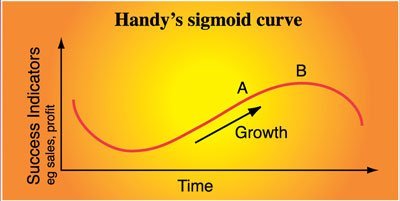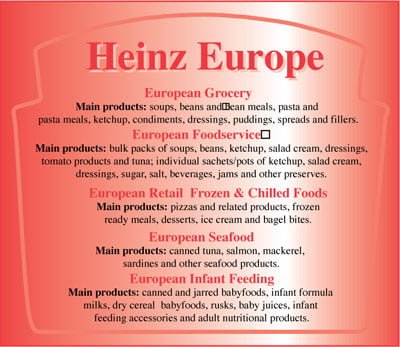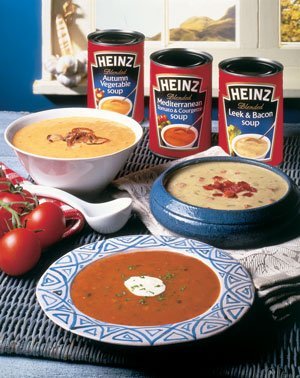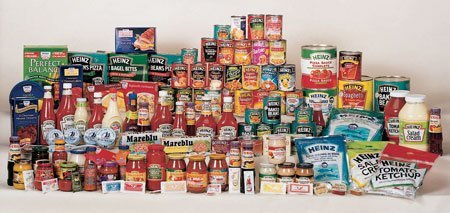The business writer, Charles Handy, illustrates the need for organisations to reinvent themselves by the sigmoid curve – effectively an ‘S’ shape on its side. An organisation which appears to be successful is on the upward growth path of the curve (point A). At this time, the organisation is making high sales and profits and is able to pay healthy dividends to shareholders. You may think, therefore, that there is no reason to change the organisation.

However, this organisation is close to its peak (point B). Beyond this point, the organisation may go into decline and be less successful. The time to change is at or before point A. The intelligent organisation will seek to reinvent itself and come up with new ideas in order to keep ahead of the competition. This is important as competitors will also be seeking to erode any competitive disadvantage that they may have.
This case study focuses on the way in which Heinz, one of the world’s major global companies, has set out to reinvent itself at a time when it is already preeminent in a range of global food markets. The study examines aspects of Heinz’s ‘Project Millennia,’ an international restructuring plan announced in 1997, which chairman Dr Tony Reilly describes as ‘delivering the 21st century early’. In particular, the study considers the way in which Heinz has re-organised its European operations to create a pan-European structure based on eight global categories.
The global Heinz Corporation
Like many global producers today, the Heinz Corporation started off from a small scale and localised business. The first product produced by Henry John Heinz in 1869 was horseradish, followed by pickles, sauerkraut and vinegar. These were delivered by horse-drawn wagons to grocers in and around Pittsburgh, Pennsylvania. In 1875, a new product was introduced which still flourishes today – tomato ketchup.
Over time, Heinz expanded in the USA and around the world, at first through internal growth (i.e. ploughing back profits into investment in new plants and equipment), but since the 1960s, by acquisition and brand building (i.e. taking over well known producers of products and brands that complement Heinz’s existing ones). Today, Heinz has 50 affiliates operating in some 200 countries, offering more than 5,000 varieties.
Heinz has also developed a strong worldwide focus on eight global product categories in which it possesses unique competitive advantages and opportunities:
- foodservice
- infant feeding
- ketchup, sauces and condiments
- weight control
- seafood
- pet products
- frozen foods
- convenience meals.
In business, it makes sense to concentrate on what you do best – your best lines. All organisations therefore need to build organisational structures which make it easy to:
- concentrate on best lines
- identify new opportunities arising in these areas
- channel resources and initiatives into best lines and particularly into new opportunities
- effectively manage best lines and opportunities
- encourage innovation and a ‘can do’ approach.
Heinz’s Project Millennia is all about enabling the organisation to adapt and change so that it has the necessary flexibility to take the opportunities which will yield the highest possible returns. As part of this worldwide reorganisation and growth initiative, Heinz unveiled plans to focus on Europe-wide category management of its core businesses. Products and markets which offer the greatest potential for future growth and return on investments benefit from this category management approach, while product development, manufacturing, sales and marketing are directed to exploit opportunities in the most cost-effective manner.
By using this new approach, Heinz is able to respond quickly to changing consumer patterns on a Europe-wide scale – if, for example, tomato flavoured pizza bases prove to be popular with an individual country’s customers, then Heinz has the operational systems and marketing strategies to quickly meet this area of growth at a pan-European level.

One of the main reasons for changing the organisational structure has been that Heinz can now look at its categories on a pan-European basis, making sure that resources are directed where the greatest prospects of growth and return lie.
One of the basic facts of business life which relates to large scale production is that if you can gain the greatest share of a market, you will be able to produce at lower unit cost than rival producers of similar products. It is not hard to see why. The company which sells most is best placed to:
- take advantage of the latest advances in technology
- spread marketing and advertising costs over a wider output
- buy components and ingredients in bulk
- distribute products at lower unit costs etc.
These advantages are usually described as economies of scale. In competitive markets, therefore, it makes sense to win market share from rivals either through internal growth of the business or by acquiring complementary producers (i.e. former rivals). Once a company acquires competitive advantage as the lowest cost producer, it is likely to be able to sustain and build on this advantage.
One of Project Millennia’s aims for Heinz has been consolidation in order to become the lowest cost food producer in Europe. Heinz was already a lowest cost producer in the UK and the lowest cost producer in Europe in many of its favoured product categories. However, as Charles Handy’s sigmoid curve indicates, companies must go forward, develop and constantly improve.
At Heinz, there is no clear endpoint to any business operation – it is a process of continuous improvement. Once a lead has been built up, it is necessary to consider ways of building on that lead. This may involve developing new markets, such as Heinz’s successful drive into Eastern Europe, or developing innovative new products such as Heinz’s recent baked bean pizza line. This has been an outstanding success – the pizza achieved an 8% share of the UK frozen pizza market even before the advertising support began.
In line with the move to focus on product categories, Heinz’s management has also changed its focus towards a pan-European outlook. Management within the organisation is now thinking on a European-wide basis. Teams are being formed across Europe to share a single business philosophy where there are no country barriers. The sales structure at the company retains its local focus, however, as few customers are pan- European in their structure. The new structure combines accountability with clear objectives and focused management teams.
Heinz has also adopted a pan-European outlook for marketing, new product development and purchasing. There is increasing effort to bring together the combined skills of teams throughout Europe in adopting a category approach across Europe. For example, a single advertising agency has been appointed across continental Europe for the Heinz Tomato Ketchup business. By driving for synergies across Europe and reinvesting savings to deliver top line growth, Heinz is increasing shareholder value.

Heinz now has well established babyfood businesses in most Eastern European markets – in Russia, the Czech Republic and Hungary. It also recently bought Publitski, Poland’s leading ketchup and sauce brand, which will act in tandem with the Heinz brand in Polish and other Eastern European markets. Heinz expects to see 25% compound growth from Eastern European business in the next five years. The pet food operation in Eastern Europe and Russia is an embryo business at the moment. There are more pet owners in Russia than in the USA – a clear indicator of the potential of this operation. Heinz now has to persuade pet owners to purchase conveniently prepared Heinz animal food.

Heinz has been marketing baked beans in Russia for 18 months, an operation which was built on the back of the baby food business. The Russians enjoy eating beans, but are not used to eating them in tomato sauce. Heinz realised this was a major opportunity to build on the existing popularity of baked beans throughout other European markets. However, a certain amount of subtlety was required in introducing such a popular brand to a new market in which consumers had little awareness of Heinz Baked Beans. For the Russian and East European market, therefore, Heinz changed the label design to show the product so the consumers could see what they were buying. This resulted in a tenfold increase in baked bean sales in Russia within 12 months.

The new organisation also offers better opportunities in terms of manufacturing synergy, i.e. servicing the consumer at the lowest possible cost. For instance, with a European focus, Heinz can now choose where to produce a particular product. In some cases, it may make more sense to manufacture products for the UK in France and products for the continent at Kitt Green in the UK. Kitt Green is Europe’s largest food manufacturing plant, producing beans, soups, canned and jarred baby food and ketchup. The factory has state-of-the-art technology for production, with 1,200 cans a minute coming through these lines. These sorts of manufacturing opportunities were not possible under the old organisational structure.
European leadership
Heinz is now seeking to build firmly on its European foundations to secure European leadership in the categories it is trading in. This not only involves double digit profit growth but top-line sales growth as well. This can be illustrated by using the seafood category as an example. Heinz has recently acquired John West – giving the company leadership in canned tuna in Europe. Today, Heinz is the only global canned tuna supplier which is vertically integrated, with controls from boat to supermarket shelf.

Heinz is still involved in the process of restructuring. Ensuring that the management clearly understand what is required of them, following the restructuring, is a key priority. In addition, Heinz in Europe must deliver the objectives which the group has set – ensuring 10 – 12% earnings growth each year. The net result of the restructuring is that the newly reinvented Heinz organisation is best placed to create high level returns. Heinz has recently been able to sell off non-core lines in which returns have been low and can now focus on those core businesses which are successful. Heinz continues to focus on these core categories whilst seeking new ways to build on strengths and identify new opportunities.
